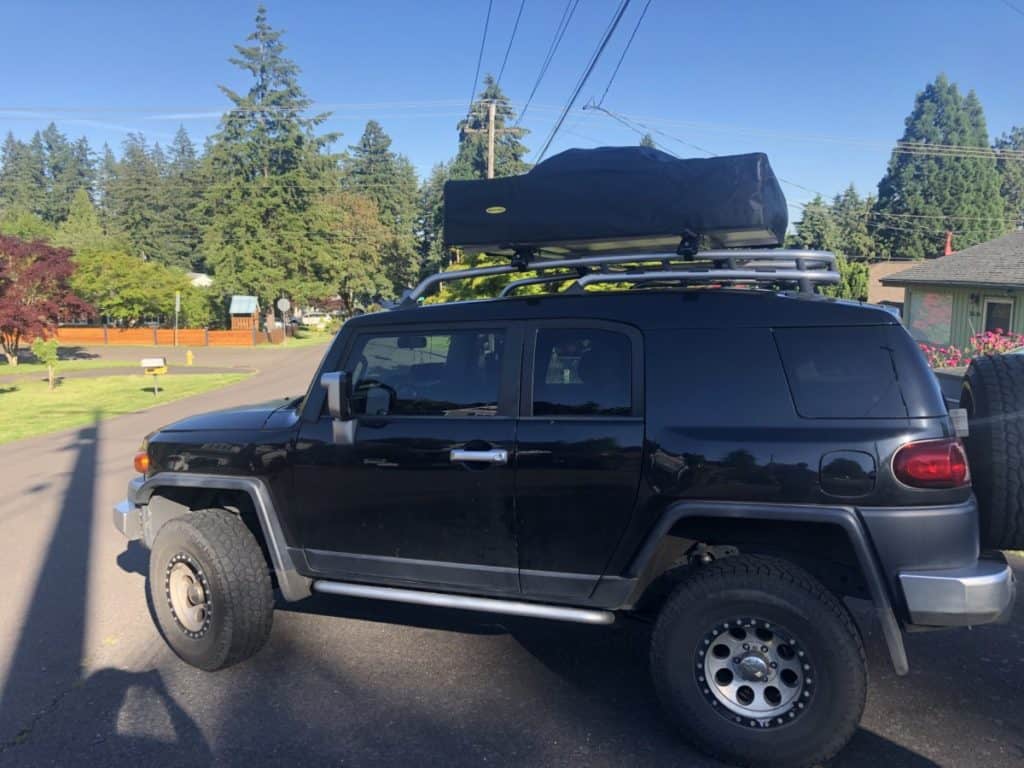For anyone that has never camped in or used a roof top tent, you may wonder how they work. From an even more basic point of view, how are roof top tents supported while they are mounted to the top of a vehicle or trailer?
Roof top tents are supported by a roof rack system that sits on top of your vehicle. The roof rack system must have crossbars in order to have the tent securely mounted to it.
While the straight forward answer is that roof top tents (RTTs) sit on a roof rack system, there are many more details to consider. How much weight can the rack hold, how much can the vehicle hold, and is there a difference when the car is in motion and parked?

These are some of the topics we will be covering in the rest of this article. Which will leave you with a complete understanding of how roof top tents are supported!
The roof rack
You won’t find a RTT mounted to a vehicle that isn’t sitting on some type of roof rack. Whether it is an aftermarket crossbar system from makers like Yakima, Thule, or Rhino-Rack, or a permanent roof rack. Both achieve the same thing and serve as a way to safely mount the RTT.
Besides the rack being able to handle the weight of you and the RTT, which we will cover in the next section, the most important thing is for the rack to have crossbars.
A crossbar will run from one side of your vehicle to the other, here is a picture of my rack and crossbar system to help illustrate. The silver part is our permanent rack and the black is the Yakima crossbar system which I am referring to.
As you can see in the picture on the right, the RTTs mounting tracks sit perpendicular to the crossbar system. This is why it is so vital for your roof rack to have crossbars. Typically, the factory crossbars that come with your vehicle CANNOT handle the weight of a RTT.
It took me hours to find the proper crossbar towers to fit my existing roof rack as well as the crossbars that can handle the weight of my RTT. If you’re in a similar stage or simply curious, I highly recommend reading our article on Choosing a Rack System For Your RTT!
This shorten your research time drastically and also serve as a helpful guide with pictures and unbiased suggestions!
If you have a permanent roof rack with mounting track the run from front to back of your vehicle, you can install the mounting tracks on the RTT sideways which will allow your tent to open to the back of the vehicle and not the side.
This trick only works for softshell RTTs that fold out and not hard shells which must sit on a crossbar system.
Vehicle and rack weight limits
Now that you have a solid understanding of which racks should be used to support a RTT, it is just as important to understand some key weight limits.
First, you need to check the weight limit of your vehicle’s roof! More times than not, this won’t be an issue. Vehicles are designed to hold their own weight in the event that they flip over. However, if you have a really tiny sedan I would recommend double-checked in your owner’s manual just to be safe.
Now let’s talk about roof rack weight limits. This is a much more research-intensive process since each rack can handle a different amount of weight. There are two extremely vital numbers to know when looking at a roof rack system.
The dynamic weight limit (DWL) is how much weight the rack can support while the vehicle is in motion. This is vitally important because the last thing you want is to be driving down the highway and have your tent fly off the roof.
When rack manufacturers list the weight limit of their racks, they are almost always speaking in terms of DWL.
The other weight limit to be familiar with is the static weight limit (SWL), which is the weight limit when the vehicle is NOT in motion (parked). Generally, you can expect a crossbar system to hold roughly 700 pounds give or take.
This is important for obvious reasons so you don’t overload the RTT with too much weight. RTTs themselves can handle about the same weight. They usually range from 650 pounds and up.
What else can support a RTT?
At the end of the day, a RTT is supported by a roof rack. However, it can be mounted in various places. Whether it be the bed of your truck, a trailer, UTV, etc.
The options in which you can mount your RTT are endless. If you want to see all of the possible ideas for mounting a RTT, you can check out this article as a fun read!
Wrapping Up
While the roof of the vehicle usually supports the RTT, the roof rack is the most vital component to holding your tent in place. The RTT is mounted to your crossbar system, and the crossbar system is mounted to your side rails attached to your vehicle.
In theory, it is very simple, but in practice, it is vitally important to not over exceed any weight limits. If you have found this information helpful I recommend checking out our Youtube channel for more interesting and helpful information.
If you want to see the items I use for my camping expeditions, head over to the recommended gear page! There you will find some unbiased reviews of the items I have tried and tested throughout my year’s camping.
Overall, RTTs are simple once you understand all of the different components and weight limits that go into it. Thank you for reading, I hope I was able to answer all of your questions on how RTTs are supported!

